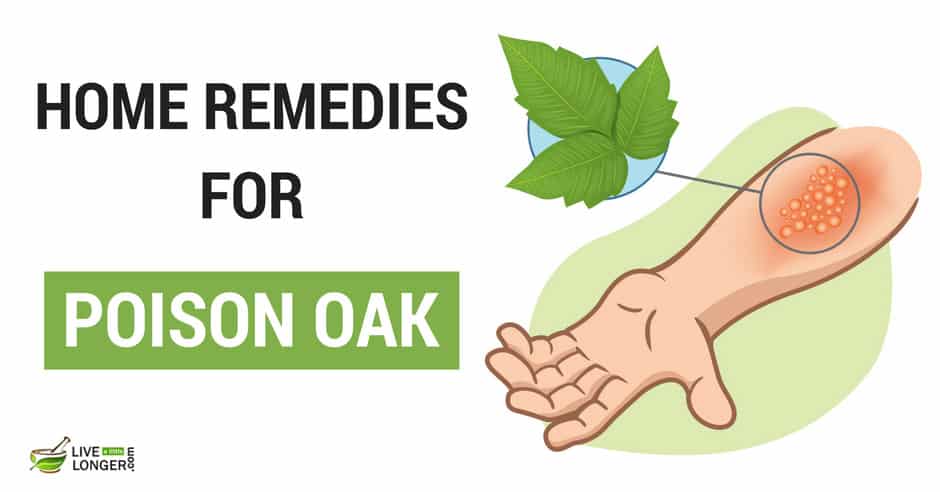Poison oak is a plant that is poisonous and can cause severe allergies when it encounters the skin. It is similar to other deadly creepers like poison ivy and poison sumac, which grow commonly in several parts of the world, and is found extensively in the United States. It causes severe itching and formation of rashes when you start scratching the itches. Being allergic to any one of these toxic plants gives you more chances of being allergic to all three of them, hence more reason to be extra careful.
It is the sap of the plant, which is oilier in nature that is responsible for the allergic reactions. This sap or oil, known as urushiol is present in all the three plants. You can get affected by the poison by stepping on the poison oak plant (barefoot) or if you happen to cut it, crush it (for reasons best known to you) or simply brush against them or roll over them. All these actions can trigger the plants to release the oil, which is toxic and will work on the skin to cause irritation and allergic reactions. However, there are home remedies for poison oak that can help.
Causes of Poisoning by Poison Oak
- Contact with the oil oozing out of the Poison Oak Plant
- Brushing against the plant (any part of the exposed body) causes irritation
- Stepping on the plant while barefoot can cause skin irritation
- Contact in a similar manner with other plants like Poison Ivy and Poison Sumac
Symptoms of Poisoning by Poison Oak
- Uncontrollable itching on the affected portion of the skin
- Distinctive red marks on the skin that was in contact with poison oak
- Small bumps or hives forming on the parts of the skin that were exposed
- Formation of blisters that ooze fluid
Note: Before you commence administering any of the home remedies for poison oak listed below, ensure that you wash the affected portion with clean water. Douse the affected part and hold it under a stream of water for at least 10 minutes so that the poison on the top layer of the skin is washed off. Use only cold water to wash the affected portions as warm or hot water tend to open up the pores, allowing the poison to seep into the skin. Once done, wash your hands thoroughly with mild soap and water.
5 Best Home Remedies For Poison Oak

5. Ice pack
Procedure:
- Collect a handful of ice cubes from the refrigerator
- Bundle them up in a piece of clean washcloth
- Apply the ice pack to the affected portion of the skin
- Repeat the process 2 to 3 times during the day
How does this work?
While an ice pack can give instant relief, it is good only for a mild case of poisoning by oak poison. Applying an ice pack relieves the itchiness and burning sensation, and helps contain the inflammation if any. The ice pack works on the underlying tissue of the skin, which may be bleeding due to the harmful effect of this noxious weed. An ice pack also helps in reducing the associated muscle pain and spasms, if any and offers instant relief. However, if the poisoning is severe, consider any of the other forms of treatment listed below.
The ice pack is useful for preventing stiffening up of the affected area and prevents any accumulation of toxic fluid that could have been triggered by the poisoning. An ice pack against the skin causes a temporary numbness, thus offering relief from the intense pain and itching.
The remedy is not good, if:
Do not apply the ice cubes directly on the affected portions of the skin. This can only aggravate the condition and cause more damage to the skin. If ice cubes are not available immediately, consider using any frozen vegetable or a slice of meat that you have stored in your fridge. Either of these is equally effective and can be applied directly to the skin.
4. Baking Soda
Procedure:
- Take 2 tablespoons of baking powder
- Mix the baking powder in 1/4 cup of clean water
- Make a thick paste of baking powder and water
- Apply on the affected portions of the skin and allow to dry
- Repeat the process 2 to 3 times in the course of the day
How does this work?
This wonder healing powder, which is sure to be found in most of the households, is an amazing medicine that has so many applications. Baking soda is safe to use on the skin of children or adults, and its mild alkaline property has a soothing effect on the poison that is embedded in the skin. Apart from offering relief from the pain, baking soda acts as a soothing balm that relieves the itching sensation and reduces the swelling, if any.
Another method of using baking powder as a natural treatment for poison oak is to dilute two tablespoons of baking powder in about 1 liter of water. Soak a gauze pad in the solution, cover the affected portions with it, and let it sit for a good 10 to 15 minutes. Repeat the process 2 to 3 times during the day and you will get relief from the poisonous effect of poison oak.
Be careful while applying the baking soda paste or solution near the eyes, lest it enters the eyes and causes irritation and damage. Do not apply baking soda directly on the skin as it might cause some aggravation.
3. Honey and Turmeric
Procedure:
- Take 2 teaspoons of raw, pure honey
- Take 1 teaspoon of pure turmeric powder
- Mix honey with turmeric powder to make a paste
- Apply the honey-turmeric paste on the affected portions
- Repeat process 2 to 3 times during the course of the day
How does this work?
Honey is one of the best natural remedies for skin that has been used for ages as folk medicine. The antibacterial properties of honey make it one of the best natural remedies for poison oak. This natural antibiotic works as an effective antidote to the poisonous effects of poison oak and help nullify the effects.
Turmeric has been promoted as one of the best remedies for various skin conditions and is a harmless and effective medicine. The group of compounds known as curcuminoids, which include curcumin (diferuloylmethane) desmethoxycurcumin and bisdemethoxycurcumin give it its anti-inflammatory properties that have no side effects whatsoever. This natural antibacterial agent is also a great natural antibiotic, which make turmeric the best natural treatment for poison oak.
The remedy is not good, if:
There are no known side effects of using honey and turmeric.
2. Do-it-yourself herbal mixture
Procedure:
- Take 1 teaspoon of pure turmeric powder, Take 1 teaspoon of natural neem (Azadirachta Indica) powder, 1 teaspoon of Manjistha Powder, Fuller’s Earth, (if not available, choose clean mud), 30 to 40 ml of clean water, and a few drops of organic neem oil.
- Mix all the ingredients (except neem oil) in water to make a paste. Apply the DIY herbal mix paste on the affected portions. Allow the application to dry naturally
- Once dried, gently rub off the dried paste. Apply a few drops of neem oil and massage on the skin. Repeat process 2 to 3 times during the course of the day
How does this work?
Ancient Ayurvedic texts extol the virtues of turmeric and the potency of the herb neem (margosa), which has high antibacterial properties and is considered a great neutralizing agent for various poisonous substances. Manjishtha (Rubia cordifolia), also known as Indian madder is a wonder herb that has been valued for its medicinal properties for ages. It is a bitter astringent that has strong curative properties that work wonders on the skin. It is also considered to be a blood purifier. This potent antioxidant also has antibacterial, antimicrobial and anti-inflammatory properties, making it one of the best natural remedies for poison oak.
Turmeric is known for its antibacterial and antiseptic properties, and the quick cures it offers for various skin afflictions. Neem (Azadirachta Indica) is a great natural antimicrobial herb that also has antiseptic properties that are very effective in treating skin disorders. When neem is mixed with Manjishtha, turmeric and Fuller’s earth, it makes a very effective do-it-yourself herbal mixture, which is potential, and a great natural treatment for poison oak.
The remedy is not good, if:
There are no known side effects of using this remedy.
1. Peppermint essential oil and Potato
Procedure:
- Take one large potato and wash it. Put the potato in a blender and grind it to a fine paste.
- Add a few drops of undiluted peppermint essential oi and 1 tablespoon of salt to the mixture.
- Add a little water to the mixture and make into a thick paste. Apply the paste on the affected portions and allow to dry. When application is fully dry, wipe it off.
- Apply a teaspoon of coconut oil and rub on the affected portions. Repeat process 2 to 3 times in the course of the day
How does this work?
Peppermint essential oil has a cooling effect on the skin and offers immense relief from the burning sensation cause by poison oak. It is also an effective microbial agent and soothes the skin while destroying the harmful bacteria present in the skin. It has also been used effectively in treating common skin problems like acne and acts as an excellent skin toner.
Potato, a starchy vegetable belongs to the Solanaceaene family like other vegetables such as tomatoes and eggplants. Apart from having high nutritional value, potato is used for treating common skin conditions like dark circles under the eyes, removal of wrinkles, removing dark spots, etc. It works as an excellent remedy for the natural treatment of poison oak along with the other ingredients mentioned above.
Coconut oil is one of the best home remedies for poison oak. It acts as a natural skin moisturizer and contains medium-chain fatty acids, also known as triglycerides, which have a soothing effect on the skin. They help the skin attain a smooth texture. It also contains the important Capric, Caprylic and Lauric acid, which are all fatty acids with strong disinfectant properties as well as antimicrobial properties that help fight infection. The Vitamin E content in coconut oil assists in repair of damaged skin and helps keep it smooth and devoid of cracks or marks.
The remedy is not good, if:
There are no known side effects of using this remedy.
Important tips to note:
- Severe cases can result in swelling of the face, often reaching up to the eyes and extending to the lips and tongue.
- Difficulty in swallowing or breathing indicates a severe case of poison oak poisoning.
- A sense of feeling unwell and being restless.
- If such conditions persist, it is advisable to see a doctor immediately.
- Poison oak can be identified by the three leaves it has
- The leaves may be glossy or dull and can vary in length from 1 to 4 inches
- The leaf edges appear to be serrated.
- It is best to avoid the areas where poison oak grows in abundance
- The toxic oil is released only when there is damage to the leaves or the plant


